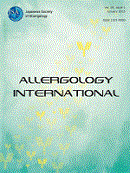Volume 59, Issue 1
Displaying 1-12 of 12 articles from this issue
- |<
- <
- 1
- >
- >|
REVIEW ARTICLE
-
2010 Volume 59 Issue 1 Pages 1-8
Published: 2010
Released on J-STAGE: March 16, 2010
Download PDF (144K) -
2010 Volume 59 Issue 1 Pages 9-14
Published: 2010
Released on J-STAGE: March 16, 2010
Download PDF (196K) -
2010 Volume 59 Issue 1 Pages 15-19
Published: 2010
Released on J-STAGE: March 16, 2010
Download PDF (149K) -
2010 Volume 59 Issue 1 Pages 21-31
Published: 2010
Released on J-STAGE: March 16, 2010
Download PDF (349K)
ORIGINAL ARTICLE
-
2010 Volume 59 Issue 1 Pages 33-41
Published: 2010
Released on J-STAGE: March 16, 2010
Download PDF (485K) -
2010 Volume 59 Issue 1 Pages 43-51
Published: 2010
Released on J-STAGE: March 16, 2010
Download PDF (244K) -
2010 Volume 59 Issue 1 Pages 53-57
Published: 2010
Released on J-STAGE: March 16, 2010
Download PDF (150K) -
2010 Volume 59 Issue 1 Pages 59-66
Published: 2010
Released on J-STAGE: March 16, 2010
Download PDF (277K) -
2010 Volume 59 Issue 1 Pages 67-73
Published: 2010
Released on J-STAGE: March 16, 2010
Download PDF (391K) -
2010 Volume 59 Issue 1 Pages 75-82
Published: 2010
Released on J-STAGE: March 16, 2010
Download PDF (349K)
CASE REPORT
-
2010 Volume 59 Issue 1 Pages 83-86
Published: 2010
Released on J-STAGE: March 16, 2010
Download PDF (131K) -
2010 Volume 59 Issue 1 Pages 87-91
Published: 2010
Released on J-STAGE: March 16, 2010
Download PDF (699K)
- |<
- <
- 1
- >
- >|
